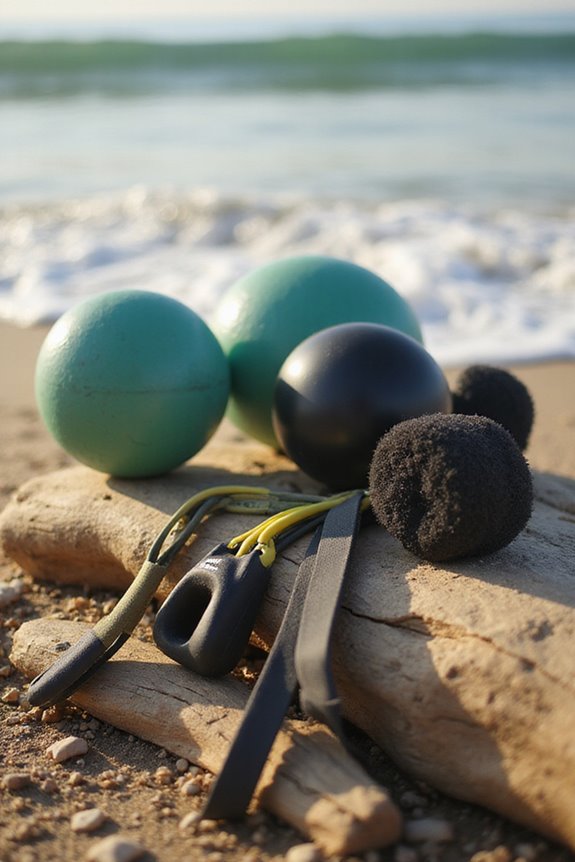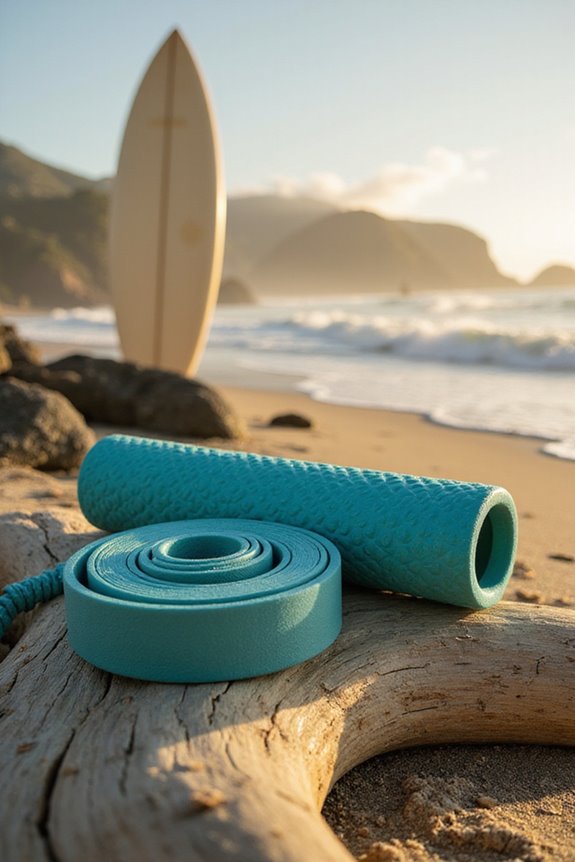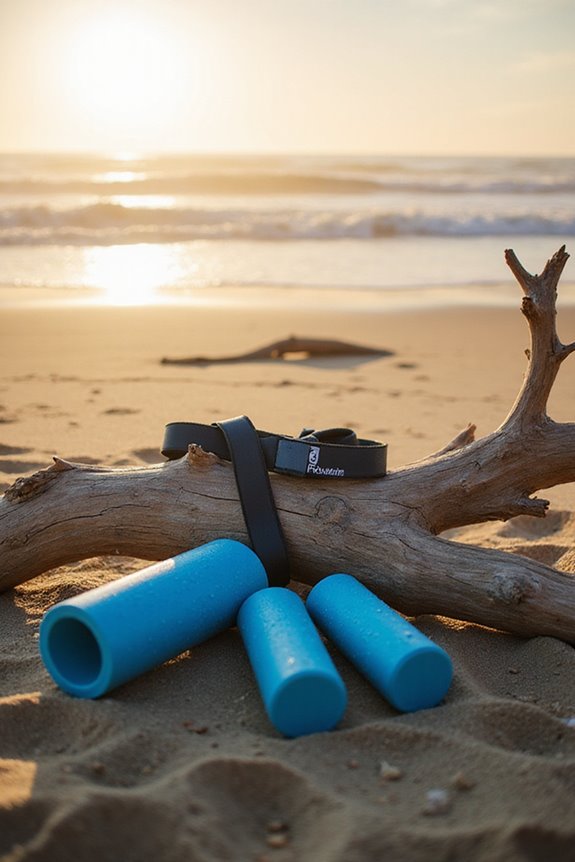To prevent surfing injuries, we should prioritize dynamic stretching. This includes exercises like leg swings and arm circles, which enhance flexibility and muscle elasticity. Key stretches for surfers involve targeting hips and lower back, such as Pigeon Pose and Cobra Stretch. These not only improve flexibility but also boost coordination and posture. Remember to focus on static stretches post-surfing for recovery. By following an effective routine, we can greatly reduce injury risks and enhance performance. More details will follow.
Key Takeaways
- Incorporate dynamic stretching for 10-15 minutes to enhance flexibility and warm up muscles effectively before surfing.
- Perform Pigeon Pose to improve hip and glute flexibility, crucial for surfing movements.
- Utilize the Kneeling Hip and Quad Stretch to target hip flexors and quadriceps, preventing tightness and injury.
- Include The Cobra Stretch for spinal mobility, helping reduce lower back pain common in surfers.
- Finish with static stretches post-surfing, holding each for 20-30 seconds to aid muscle recovery and flexibility.
The Importance of Dynamic Stretching for Injury Prevention
When we engage in activities like surfing, the risk of injury can greatly increase without proper preparation. Dynamic stretching plays an essential role in enhancing dynamic flexibility, which helps us warm up our muscles effectively. By raising body temperature and improving muscle elasticity, dynamic stretching prepares our bodies for the demands of surfing.
This type of stretching also activates the nervous system, enhancing neuromuscular coordination and reaction time—key factors in preventing injury mechanisms during surfing maneuvers. Additionally, it improves our range of motion, reducing the risk of strains. With high injury rates in surfing, incorporating dynamic warm-ups is critical. They not only prepare us physically but also align our movements with the sport’s demands, ultimately lowering our injury risk. Engaging in flexibility and balance exercises, such as yoga, further enhances our ability to navigate challenging conditions on the water.
Common Stretching Practices and Their Limitations

Although many surfers incorporate stretching into their routines, the effectiveness of these practices can vary considerably. Static stretching, often performed prior to surfing, lacks strong evidence for preventing injuries and may even decrease muscle strength and power when done right before activity.
Many of us focus on static stretches for our limbs, yet injuries frequently occur in these areas, highlighting a limited protective effect. In addition, static routines alone don’t adequately warm up our muscles or improve blood circulation.
While over half of surfers perform warm-up practices, the type and duration can greatly affect their effectiveness. A well-rounded warm-up should include dynamic movements to enhance muscle readiness and overall performance while reducing injury risk. Additionally, participating in surfing lessons can help surfers understand proper techniques and safety measures that contribute to injury prevention.
Key Stretches Targeting Areas Most Injured in Surfing

To effectively prevent injuries while surfing, we need to focus on key stretches that target the areas most commonly affected by the sport.
Hip Flexibility Stretches:
- Pigeon Pose: Enhances hip and glute flexibility, improving balance and pop-up mobility.
- Kneeling Hip and Quad Stretch: Stretches hip flexors and quadriceps, aiding our surfing stance.
Lower Back and Core Stability Stretches:
- The Cobra Stretch: Increases spinal mobility and strengthens the back, reducing lower-back pain.
- Torso Twist Variations: Engages the core while stretching the spine and obliques for better wave riding.
Incorporating these stretches into our routine can enhance our hip flexibility and core stability, greatly reducing the risk of injuries during surfing sessions. Additionally, maintaining proper wetsuit fit can also play a significant role in preventing discomfort and enhancing performance while surfing.
Benefits of Specific Stretching Postures

Understanding the benefits of specific stretching postures can greatly enhance our surfing experience and safety. By incorporating specific stretch benefits into our routine, we improve muscle elasticity, lowering the risk of tears and strains. Dynamic stretches prepare our muscles and joints for sudden movements, enhancing injury prevention techniques.
Moreover, stretching boosts neuromuscular activation, improving our coordination and balance on the surfboard. This means we can respond quickly to wave dynamics, reducing the chances of falls. Increased joint mobility and range of motion are essential for executing complex maneuvers. Finally, better posture and body alignment through stretching help us maintain stability, ultimately enhancing our overall performance and enjoyment in the water. Additionally, incorporating balance training equipment into our routine can further elevate our surfing skills and injury prevention efforts.
Recommendations for an Effective Stretching Routine

When we look to establish an effective stretching routine for surfing, it is crucial to balance dynamic and static stretches to prepare our bodies adequately. We should start with dynamic stretches, lasting about 10-15 minutes, to warm up our muscles without fatigue. Leg swings and arm circles can help increase blood flow and joint mobility.
After surfing, we should focus on static stretches to aid muscle recovery, holding each for 20-30 seconds. Key stretches include lying knee roll-overs and kneeling hip stretches. Incorporating flexibility training into our routine can further enhance performance and prevent injuries.
To optimize flexibility and prevent injuries, we recommend stretching 2 to 3 times per week. By maintaining a consistent stretching frequency, we can enhance our performance and enjoy a safer surfing experience.
Frequently Asked Questions
How Often Should I Stretch to Prevent Injuries While Surfing?
To prevent injuries while surfing, we should incorporate stretching into our daily routine. Consistent stretching enhances flexibility and muscle readiness, considerably reducing injury risk and helping us perform better on the waves.
Can I Stretch After Surfing to Aid Recovery?
Absolutely, we can stretch after surfing to aid post-surf recovery. Gentle stretches promote muscle relaxation, helping us counteract fatigue and soreness, ultimately enhancing our overall performance and enjoyment in the water during future sessions.
What Are the Signs of Overstretching During Warm-Ups?
We shouldn’t dismiss overstretching symptoms during warm-ups. If we notice sharp pains or muscle tremors, it’s a sign to adjust our warm-up techniques, ensuring we prepare our bodies safely and effectively for activity.
Is There a Best Time of Day to Stretch for Surfers?
We believe the best time to stretch is during our morning routine for muscle readiness and flexibility, and in the evening for relaxation and recovery. Balancing both helps us maximize our surfing performance and enjoyment.
Should Beginners Focus on Dynamic or Static Stretching First?
When we start surfing, we should focus on dynamic stretching first. It warms us up and preps our muscles for action. Static stretching can come later, aiding recovery and flexibility after our sessions.







